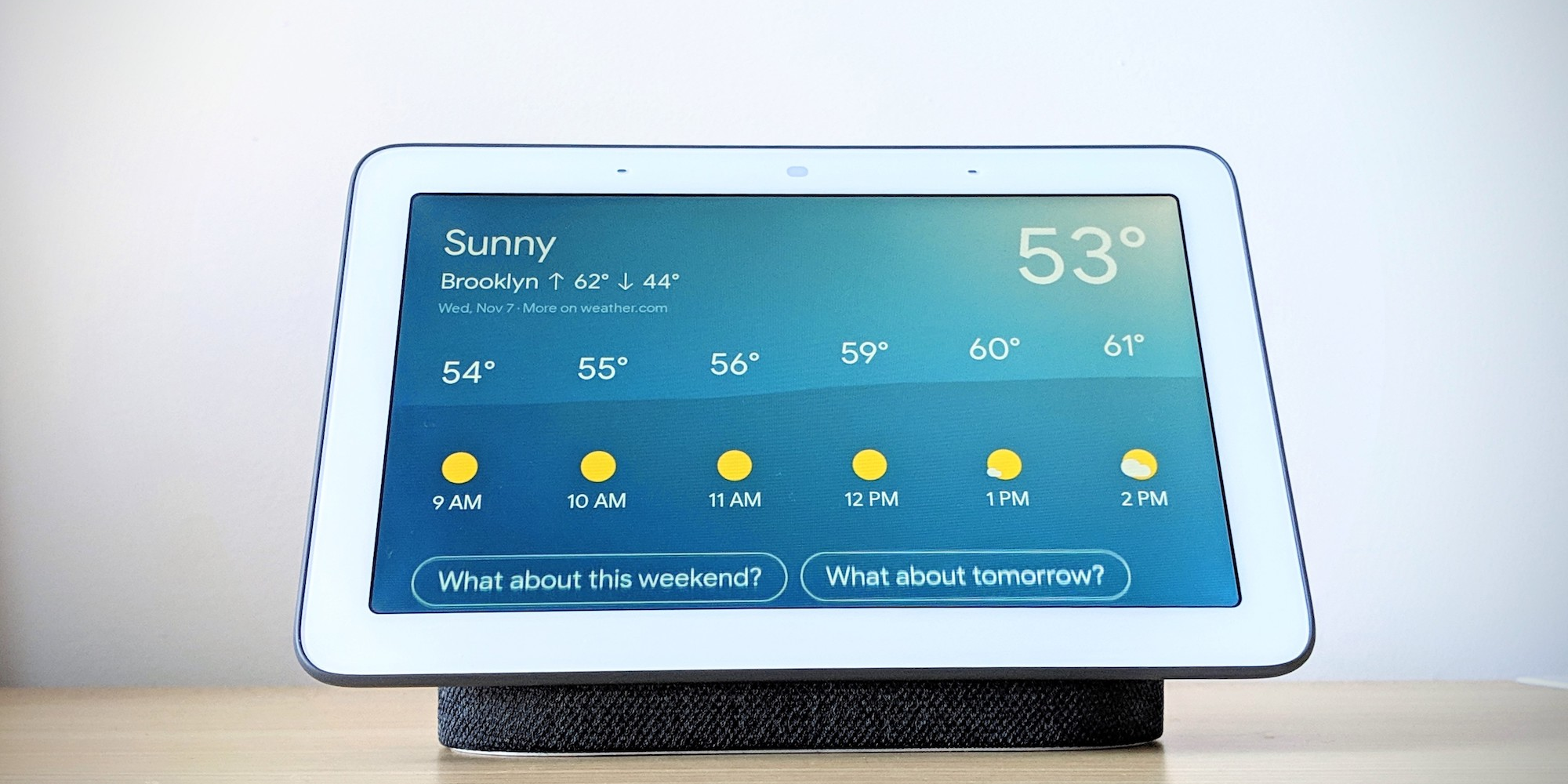With its latest smart-home device, Google wants to run your life – or at least your home.
The Google Home Hub, which debuted last month and costs $150, is the first Google Home device with a screen. It’s intended to serve as a hub for all your smart-home devices, a place to watch YouTube videos, and a visual portal into your schedule, the weather, and nearby traffic.
Oh, and it has Google Assistant built in too.
I’ve been using the Home Hub in my home for the past few weeks, living with it and using it like my other Google Assistant products. Here’s what I’ve found.
The Google Home Hub is smaller than you think it will be.

The one thing that most surprised me about the Google Home Hub is its size. The device, which has a 7-inch touchscreen display, is less than 5 inches tall and 7 inches wide (or 188 millimeters by 178.5 millimeters).
At first, its small size seemed like something of a mistake on Google's part - after all, we're in an era where everyone is making their displays as large as possible.
But once I got the Home Hub into my home, I saw the value in making the device that size: It fits anywhere.
The Home Hub has a small footprint, so it fits nearly anywhere you want it to, like a nightstand, a kitchen counter, or even on the bathroom vanity, if you're so inclined.
Plus, it's good-looking. I've been testing the charcoal version, and it fits in perfectly with my kitchen, which has gray cabinets and white countertops.
Its display isn't super high-end, but I had no issues with it.

The Home Hub has an LCD display, which is generally considered slightly inferior to the high-end OLED displays of devices like Google's new Pixel 3 phone.
That said, I've been impressed by the quality of the display so far. It's bright and sharp, and everything from photos to videos looks great on it.
One nice feature of the Home Hub display is the ambient EQ light sensor that lives directly above the screen. When that sensor detects it's dark in a room, it will dim the display or shut it off. This is a nice feature if the Home Hub is in a spot like your living room and you dim the lights to watch a movie - and especially nice if you keep it on your bedside table.
I actually found myself wishing the Home Hub had a camera.

Google purposely didn't include a camera on the Home Hub to make it more versatile. No camera means people will feel more comfortable putting it in their bedroom, or bathroom, or any other room in their home - at least, that's what Google hopes.
While that's a noble decision, I was surprised that I found myself wishing it did have a camera, if only so I could video chat with my family.
My family lives across the state from me, and two of my siblings have Pixel phones, meaning I use Google Duo, Google's video-chat app, pretty often. The other night, I was video chatting with them and my niece and nephew while cooking dinner, and I would have loved to be able to take the call on the Home Hub sitting on my kitchen counter instead of on my phone, which was propped at an odd angle and has a pretty small screen.
That said, most people probably won't feel the same way I do. No camera means zero likelihood of a hacked camera - and more privacy for you and your family.
The Home Hub can do more than you probably need it to.

The Home Hub can do a lot of things, like play YouTube videos, show you directions, display recipes, and control your smart home.
It quickly became part of my morning routine to use the Home Hub to look at my commute, my schedule for the day, and the weather. (The Home Hub will show you a visual forecast and read it aloud, which is much more helpful than just a spoken forecast from Google Assistant.)
But there were a lot of Home Hub uses that I didn't really find myself needing:
- I didn't enjoy listening to music on it. Perhaps it's because I had a Google Home Max in the same room, but the Home Hub's speakers sounded thin and weak compared with the impressive sound of the Home Max.
- I never found the time to watch YouTube videos on it. At this stage in the game, most of us are oversaturated with screens, and the Home Hub was a prime example of that. While it can play YouTube videos, so can my phone, and I didn't often think to turn to the Home Hub when I wanted to watch something - it was second or third on the list after my phone and laptop. I could see the Home Hub being great for people who avidly watch cooking or makeup tutorials, but I never had an instance where my phone wasn't an easier option.
- If you don't have a maxed-out smart home, you're wasting its potential. At first, I thought the Home Hub would be great for me because I already have several other Google Home devices in my house: the Max and two Home Minis. But they don't require me to have a hub - they work just fine without one. I live in a pretty small apartment, and I'm not allowed to have a lot of smart-home devices, like outdoor security cameras, but I'm sure that if I had a Nest, or a video doorbell, or a security camera, or smart lighting, a hub would be a dream come true. As it is, it feels as though I'm wasting a chunk of the Home Hub's potential.
But you can also just use the Home Hub as a smart photo frame, and that's OK too.

The best feature of the Google Home Hub, hands down, is the ability to use it as a digital photo frame.
I know, I know. Photo frames seem so mid-aughts. We've moved past that technology, right?
Well, maybe not.
What makes this Home Hub feature so great is that it pulls images of people and places you've preapproved from your Google Photos account. The device will automatically eliminate ones that are blurry or are of things like receipts.
The photos show up when you're not using the device - it's one of the "ambient modes." But you can also have the display show a full-screen clock or an art gallery.
The Home Hub doesn't just show an endless slideshow of random images. Over time, I've noticed the device displaying collages or side-by-side images with the same subject. I didn't tell it to do that - it just figured out that I might like to see two photos of, say, my sister's dog, right next to each other.
I have noticed the feature gets tripped up from time to time. My niece and nephew looked very similar as newborns, and sometimes Google Assistant thinks it's showing me a few photos of the same baby when it's not. Otherwise, however, it's been pretty accurate.
The reason this feature has been my favorite is simple: It consistently brings me joy, and it makes the people who visit my apartment happy too. My parents and sister have all visited me in the past few weeks, and they've been delighted by the family photos scrolling by on the display. The Home Hub will often show me a photo I've forgotten about or an image from a vacation, and it makes me happy every time.
So should you buy the Google Home Hub?

There are two types of people who should buy a Home Hub: those who have a maxed-out smart home, and those who don't yet own a single smart-home device.
My reasoning with the former category is that the idea of the Home Hub is to take the hardest thing about setting up and maintaining a smart home - the countless individual apps you need to control everything - and put it in one easy-to-use location. Being able to watch a live feed from your security camera, or tapping the screen to control the lights, would be a game-changer.
On the other end of the spectrum are people embarking on their first smart-home product, or their first device with a smart assistant. The Home Hub is great for that too, because it acts as a jumping-off point: You can start with the hub, then add other devices as you go. And if you learn how to use a smart speaker on the Home Hub, adding a Google Home Mini or Home Max down the line will be that much easier.
I fall somewhere in the middle, and because of that, the Home Hub felt like a bit of an extravagance. I felt as if I were able to use only 50% of its capacity and that a lot of its potential use cases were wasted on me.
But I can't deny that the Home Hub made me happy on a daily basis, thanks to the Google Photos ambient mode, the on-screen weather, calendar, and traffic, and the additional nifty features, like the auto-dimming display. I even noticed that when I had a reservation at an Italian restaurant, Google Assistant adopted an Italian accent to tell me the details.
For all that, $150 doesn't seem like too big a price to pay.
Note: All the photos in this review were shot with the Google Pixel 3.

